CARTOONING
THE ROARING TWENTIES
Part Two:
January 1923 - December 1925
TWENTIETH
CENTURY AMERICA didn't begin in 1900 or 1901. Until World War I was over, the
twentieth century in America was little more than an attic for the nineteenth—
full of the dusty and slightly threadbare notions of a fading Victorian Age and
the mouldy pioneering axioms of the westward movement. But in the 1920s, the
salesman replaced the frontiersman in American culture, and with that,
Twentieth Century America was born.
Mass
production more than anything else created what we know as modern America.
Goods produced in the vast quantities made possible by assembly-line methods
demanded an entire nation of consumers, and in fomenting a nation of consumers,
the salesman and his henchman, the advertising man, created also a national
audience.
Advertisements
concocted in New York to sell products manufactured in Detroit were read in
periodicals published in Chicago that were sold from coast to coast.
Everywhere, everyone read virtually the same things. Even local newspapers,
fed by national wire services, press associations and feature syndicates, were
disseminating the same news and ideas in every corner of the land.
And
the nation's readers were bound even closer together as they became the
nation's listeners when the newest marvel of the age swept across the country.
The first radio station began by broadcasting the Cox-Harding Presidential
election returns November 2, 1920, and was heard only by amateur wireless
operators. By the close of the decade, radio had every citizen in its thrall:
listeners from Maine to California stopped whatever they were doing every
evening to listen for fifteen minutes to "Amos `n' Andy," one of the
earliest radio serials.
During
the 1920s, national radio networks and national magazines bound the nation
together as nothing else could. Everyone was in the same audience. And as one
writer of the day observed, "The national mind became as never before an
instrument upon which a few men could play." An audience weary of war and
the troubles of the world and with more leisure time than ever before seized
eagerly upon whatever distractions mass communications offered. And because
the audience was nation-wide, the distractions it seized upon became national
crazes. Whenever a new toy or a fad or a scandal engaged the public's fancy,
it was promptly and repeatedly on the front pages of every newspaper
everywhere, in feature articles in national magazines, and broadcast over the
air waves into every home in the land.
By
this means, a Frenchman named Emil Coue made his fortune by getting the country
to chant his “autosuggestions” formula for happiness and well-being: “Day after
day in every way, I am getting better.” Next, everyone was singing “Yes, We
Have No Bananas” and then doing cross-word puzzles and then marathon dancing or
flag-pole sitting.
As
for scandal, the decade soon had a lulu in the storied film colony on the West
Coast. The U.S. was on a movie-going binge. Americans flocked to the
country's 17,000 movie houses on the average of once a week to see their
favorite screen personalities. Charlie Chaplin was at the peak of his powers.
So were Mabel Normand, Douglas Fairbanks, Lillian Gish. Everyone may have been
in love with Mary Pickford, the archetypal girl next door, but vast numbers of
the audience lusted with equal devotion after Theda Bara, the industry's first
sex queen. Or Rudolph Valentino, "the great lover."
If
the movies titillated, the private lives of movie stars absolutely fascinated.
In scores of tawdry movie magazines, film folk were depicted as engaged in
madcap off-screen depravities— spending fabulous fortunes on wild parties,
booze and drugs, ostentatious homes and flashy automobiles. Then, in the fall
of 1921, came the sensation that topped all others: the popular comedian
Roscoe Conklin "Fatty" Arbuckle was charged with murder when a
starlet died after a bedroom interlude with him during one of his celebrated
orgies.
Arbuckle
was eventually found not guilty, but his career was over. And so was the long
bacchanal in Hollywood. Movie moguls, fearing a public reaction that would
hurt their box office receipts, decided to clean up the act: they drafted Will
Hayes out of Warren Harding's cabinet (which, ironically, would prove as
corrupt as Hollywood was debauched) to police the industry's morals, both on
screen and off. But sin remained popular in spite of the Hayes Office— both
with film stars and with their audience, which conducted itself through much of
the decade as if it had just discovered sex.
Some
scandals had little to do with the libido. In the summer of 1925, the nation
was entertained with daily reports from Dayton, Tennessee, where a school
teacher named John Scopes was being tried for teaching evolution. It was the
ultimate struggle of the decade—the Modernists against the Fundamentalists.
Famed Clarence Darrow offered a nobly intelligent defense, but the jury liked
William Jennings Bryan's Bible-thumping prosecution better.
Intolerance
of all sorts flourished in the twenties. Immigrants, radicals, and all
minorities were subject to attack— blacks, Jews, and Catholics in particular.
In this environment, the Ku Klux Klan flourished. Revived, some believe, by
the popularity of D.W. Griffith's 1915 movie, “Birth of a Nation,” the KKK
grew to a membership of over 4.5 million and dominated political life in the
mid-twenties in seven states.
Meanwhile,
Prohibition, the Anti-Saloon League's hope for national sainthood, was well on
its way to becoming a colossal failure. By 1923, the year the cartoons at hand
began to see print, the supply of illicit liquor was coming into the country in
a torrent— across the Canadian border, from ships lying offshore just beyond
the 3-mile limit (in "Rum Row"). Instead of being sainted, the
nation was besotted.
Breaking
liquor laws was commonplace. And almost universally condoned. Edward S.
Martin, writing in the nation's venerable humor magazine Life, reminded
his readers that lawbreakers historically were often heroes: "Among the
people who did most for human liberty and human happiness is a splendid gallery
of lawbreakers." The most profound result of Prohibition, Martin said on
another occasion, "is that it has transferred discussion from the effects
of alcohol on human beings to the effects of Prohibition on alcohol." The
quality of illegal liquor could not be controlled, and some of the stuff was
downright poison. Bad liquor killed 14 people during New Year's celebrations
in New York in 1923.
Speakeasies
were as much a part of urban life as the growing problem of streets congested
by automobile traffic. Speaks were different than saloons: since admittance
tended to be restricted to those who knew the password ("Joe sent
me"), a clubby membership atmosphere prevailed. Hence, these establishments
of the evening's entertainment became "night clubs." (And the
admission fee charged to help the management maintain the hideaway was called,
logically, a couvert charge.)
Each
night club tended to develop a distinctive ambiance. A one-time movie actress
named Texas Guinan made a career as a hostess enlivening a succession of New
York's night spots: "Never give a sucker an even break," she
advised. And she greeted her customers accordingly: "Hello,
sucker," she'd bellow from across the room.
For
a less boisterous evening, the crowds gathered at Helen Morgan's where the bad
booze was made palatable by the torch singer's husky contralto. (Illustrator
James Montgomery Flagg explained her appeal best: she was, he said, the
composite of all the ruined women in the world.)
All
bootleggers were criminals by definition, but they weren't all gangsters.
Bootlegging, however, gave gangsters the impetus to organize, and by the end of
the dry era, organized crime was an institution. Dapper Johnny Torrio did most
of the organizing in Chicago, but when the business threatened to get bloody in
1925, he prudently retired to Italy, leaving his empire to Alphonse Capone.
And, sure enough, the business got bloody.
Organized
crime didn't find its way into the cartoons of the lawless decade very often:
bootlegging could be joked about but not murder. However, in the pages of the
old Life, editoonist Charles H. Sykes sometimes reminded readers
about the cloud of criminality hanging over the country. Sykes did political
cartoons for the Philadelphia Evening Ledger on a daily basis; weekly,
he cranked up a cartoon in juicy wash for Life, and once a month, he did
a page of diminutive pen sketches commenting on the newsiest topics of the past
thirty days.
One of the star players in these monthly summaries was Sykes'
dour and disgruntled Mr. Dry, by whose regular appearance the cartoonist logged
the failures of Prohibition.
But
if there is any single image that epitomizes the era it is not the funereal Mr.
Dry in political cartoons; it is that effervescent bundle of giddy
self-assurance, girlish laughter, and unabashed sex appeal— the flapper. The
visual symbol of the flapper did not appear widely until she was an accepted
type— that is, until about 1923; but she had become a familiar social
phenomenon long before then.
The
typical flapper was a nice girl who was a little fast ("brazen and at
least capable of sin if not actually guilty of it," as Shelly Armitage
says in her biography of John Held, Jr.). The flapper offended the Older
Generation because she defied accepted conventions of decorous feminine
behavior. Women's hair had always been long; the flapper wore hers short—
"bobbed." She used make-up (which she often applied in public). She
wore tight, short dresses which bared her arms completely and her legs from the
knees down; underneath, she wore as little as possible. And on the beach, she
resorted to a skin-tight, single-piece costume that didn't cover arms or legs
and that therefore left very little of her figure to be imagined.
But
the flapper did more than symbolize the revolution in feminine fashion and
mores: she also embodied the spirit of the times in a way no other figure
did. John Held, Jr., a mere cartoonist, did more to create this
revolutionary icon than anyone else. And in the brevity and brilliance of his
career, he embodied the meteoric character of the Age of Flaming Youth that he
so aptly illustrated.
Held
(January 10, 1889 - March 2, 1958) had come to New York from his hometown Salt
Lake City in 1910, seeking a serious career as a sculptor, but he took work
with advertising firms in order to make a living and sent for his wife Myrtle
as soon as he felt secure. Formerly society editor for the Salt Lake City
Tribune, Myrtle had a kind of self-assurance that her husband, at that
time, lacked. Seeing commercial value in the comic sketches Held made after
hours, she took them around to magazines and sold them.
By
1915, Held's work was appearing in Judge, Life, The Smart Set, and Vanity
Fair. For years, his drawings were signed "Myrtle Held" or
"Babette" because those who first bought them had believed that the
woman who peddled them had also drawn them, and Myrtle, rather than give a
tedious explanation, had played along, scrawling her name on her husband's
unsigned work.
After
World War I, Held began to develop a new drawing style to portray the new
social order that was emerging in the post-war years. The Younger Generation,
disillusioned by the brutishness of the conflict and the sordid politics of its
aftermath (which demonstrated that the world was no more safe for democracy
than it had been before the War), threw itself into cynical pursuit of some
unattainable anodyne for their spiritless existence. Affecting a bored
detachment beyond their experience of life, the Young plunged into endless
rounds of drinking and pointless escapading, making merry desperately as if
there were no tomorrow.
Focussing
on their antics, Held captured their insouciance with the simple elegance of
his line, their youth with perfectly spheroid heads proportionately too large
for their bodies. Initially, Held's belles were roundish, almost plump, but at
the apogee of their evolution, they were skinny approximations of their sex,
emblematic of a sort of perpetual adolescence.
As skirts became shorter, Held
exaggerated the effect by making his girls' legs longer and slenderer, giving
them the gangling coltish appearance of youth. And so was the apotheosis of
the flapper achieved.
Humorist
Corey Ford maintained that Held actually invented the flapper by supplying the
Young with a prototype: "Each new Held drawing was pored over like a
Paris fashion plate, girls cropped their hair and rouged their cheeks and
shortened their skirts to be in style, galoshes and raccoon coats were
indispensable to every male undergraduate wardrobe. So sedulously did we ape
his caricatures that they lost their satiric point and came to be a documentary
record of our times."
Without
question, Held defined the spirit of the decade. More than any other
cartoonist, Held captured in his graphic abstractions the fashions and fads of
the collegiate jazz age. His leggy flappers with noses in the air and hose
rolled at the knee and his bell-bottomed sheiks with their hair plastered tight
to cue-ball heads personified the Younger Generation to a nation of readers. His
comic figures, shorthand caricatures in geometric shapes with mellon heads and
spindly bodies, were rendered in delicate, fragile lines against which Held
boldly contrasted solid blacks. Sophisticated and vaguely dissolute, his
short-skirted cuties were insatiable neckers, and their tuxedo-clad escorts
inveterate social bootleggers, a flask on every hip.
Held's
work appeared regularly in all the most popular magazines. At the height of
his fame, editors begged for his work. Theatrical caricaturist Al
Hirschfeld, one of Held's closest friends, tells of watching Held open his
morning mail— each of 20 or 30 envelopes containing a check for hundreds or
thousands of dollars.
By
this time, the would-be sculptor was trapped by the commercial and economic
demands of his success as a cartoonist. With a new wife in charge of their
social life, Held had to support a lavish "roaring twenties"
lifestyle, complete with weekend parties and mansions in Westport and Palm
Beach. The work ethic of his Mormon upbringing very much operative in the
cartoonist's mind, he was an absentee merry-maker: while his wife and friends
partied through the nights, he hunched over his drawingboard to earn the money
that financed the fun.
Identifying
intimately with the frivolity of the twenties, Held didn't make the transition
to the grim depression times that followed after the collapse of the stock
market in 1929. Suddenly, magazine editors no longer wanted his work, and his
cartoons soon disappeared from the national scene. In 1931, he had a nervous
breakdown. (Hirschfeld says his friend was done in by changing feminine
fashion: "The long skirt imported from Paris did it. Held's drawing of a
girl in a long dress was ludicrous. Russell Patterson, an illustrator,
replaced Held's flapper with a cleverly drawn anatomically persuasive girl in a
tight-fitting, transparent, long dress." But Hirschfeld, with the
caricaturist's occupational flair, is exaggerating, over-simplifying.
Patterson, as we'll see in the next essay in this series, was established as a
delineator of fashionable life in the twenties well before hemlines fell and
the stock market crashed and ended the party.)
During
the hard-scrabble thirties, Held wrote fiction and illustrated it, designed
stage sets, hosted a radio variety show, and became a serious artist—
watercolors and sculpture, at last.
He married his fourth wife in 1942,
and they retired to a small working farm in New Jersey. After World War II,
Held was rediscovered and enjoyed considerable reputation until his death (of
throat cancer) in 1958. And his work, documenting an era, continues to amuse
and amaze.
Held's
style was unique— without precedent or imitation. But as the ensuing parade of
cartoons attests, he was not the only distinctive cartooning stylist who
emerged in the Roaring Twenties. The cartoons hereabouts were assembled mostly
from the 1923-25 pages of the old Life, supplemented slightly by a few from
1924-25 issues of its rival, Judge. Many of the same cartoonists
appeared in both publications (and in The New Yorker when it began), and
while not all cartoonists of the day were represented in these magazines, our
samples are nonetheless representative of the period— illustrative of the
spirit of the times and of the state of the art of cartooning.
One
of the most individualistic pen techniques in the history of cartooning
belonged to Percy L. Crosby (December 8, 1891 - December 8, 1964), whose
famed newspaper strip character, Skippy, debuted in the pages of Life in
1923. The March 15 issue announced Skippy Skinner's imminent advent with the
boxed picture and copy shown nearby; the next week, the kid arrived in all his
spunky impudence as depicted next to the announcement.
Crosby's
sketchy, effortless line has a ferocious energy, the vitality born of pen
tearing breakneck across paper, and Crosby's subjects were imbued with that
energy even if drawn in repose. And the cartoonist's distinctive style of
drawing is as much a part of his nine-year-old protagonist's character as the
gags that gave him personality.
Strangely,
Skippy's anachronistic costume belies his character: attired always in an
English schoolboy's gown (smock-like jacket), high Eton collar with flaring
bow-ribbon tie, and short pants, Skippy should be a well-behaved momma's boy.
Only his shapeless hat, tilted rakishly— provocatively, almost belligerently—
over his eyes and his down-at-the-ankle socks betray him as a boy's boy, rowdy
and roguish and just a trifle quarrelsome, who swaggers into view with his
hands jammed deep into his pockets, strutting his neophyte machismo.
Skippy
proved so popular that Crosby, who owned the copyright on the character,
syndicated a daily strip version, starting June 22, 1925. Distributed at first
by bush league syndicates, Skippy was eventually taken up by Hearst,
beginning with the Sunday page in 1926; then in 1929, the dailies. (A reprint
project these days is putting Skippy between hardcovers; IDW’s Library
of American Comics is up to Volume 4, covering 1934-36, with an on-going series
of stunningly illustrated introductory essays by Jared Gardner, tracing
Crosby’s life and developing talent, year by year.)
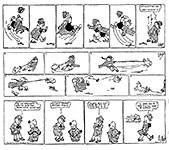 |
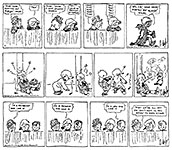 |
Largely
self-taught while on the job as staff cartoonist for the New York Globe (briefly) and then (for several years) for Pulitzer's New York World, plus
freelancing cartoons to magazines, Crosby invented several short-lived panel
cartoon features and comic strips for newspaper circulation. Among the latter
were Beany and the Gang and The Clancy Kids, both about lively
children. In the Army during the last year of World War I, he did a strip about
Army life— That Rookie from the 13th Squad—which was
syndicated by McClure and subsequently reprinted in two book collections. The
books established a reputation for Crosby.
After
the War, Crosby revived The Clancy Kids, one of whom, Timmie, is the
very image of Skippy. Also for McClure, he did a panel cartoon under several
themed headings, including Back o’ the Flats, focusing in the urban
poor, and Three Rooms and a Bath, about a young family. He continued
freelancing cartoons to Life, to which he’d sold his first cartoon at
the age of 16. Hoping for something more permanent and secure (McClure was not
an ambitious syndicate), Crosby approached the Life editor with an idea
for a regularly feature about a kid, and Skippy was born.
Crosby
had too much energy to confine his efforts solely to his strip. He was a
creative volcano, waiting to blow. During his peak years of production
(between, say, 1925 and 1940), he spewed out 14 books— novels (often about
Skippy, with whom the Brooklyn-bred Crosby identified very closely), poetry,
and essays on philosophy, politics, literature, and art. He also painted in
oil and watercolor, and he crusaded for individual rights and freedom of the
press— and against Prohibition, bootleggers, gangsterism, atheism, naval
disarmament, and pacificism.
When
editors wouldn't print his diatribes on such subjects, he took full-page ads in
large metropolitan newspapers to air his views. Skippy, Crosby’s alter ego,
often philosophized in the comic strip on Crosby's favorite subjects. Once
when an editor had the temerity to object to Crosby's fulminating in the strip,
Crosby wrote back: after wondering if the editor permitted his readers to say
up past 9 p.m., he told the editor he took orders from no one, and then he
calmly removed the paper from the strip's list of subscribers.
Tragically,
Crosby was eventually consumed by his passions. His crusades became more
furious, and he began to imagine that the objects of his tirades were plotting
to do him in. Increasingly into the forties, he made Skippy his
mouthpiece, and finally, King Features sought to rein him in. Crosby wouldn't
agree to the terms of the renewal contract he was offered, so the strip died
December 8, 1945.
Four
years later— his marriage in shambles, separated from his children, income
dwindling to nothing, unable to find a public forum, and drinking heavily—
Crosby attempted suicide. Diagnosed as a paranoid schizophrenic, he was
committed to a mental institution where he spent the last 16 years of his life
in bitter isolation from all responsive human contact, desperately trying to
secure his release (he was scarcely insane by the standards of the next
generation), writing tracts in lucid, often brilliant prose that no one would
read, and drawing pictures of favorite subjects— dancers, skaters, horses. But
never Skippy. He never drew Skippy again.
Among
our samples of cartooning in the twenties is another figure familiar to
newspaper comic strip readers— Grandma from Edwina's Cap Stubbs and Tippie. Edwina is Edwina Dumm, and her history and that of her comic strip about
a boy and his dog is recounted in Opus 377. Here, at the elbow of your eye, we
remind you of that history with Grandma’s debut in Life. 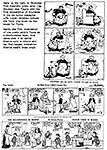
Another
of Life's cartoonists who did a newspaper feature was Gluyas Williams.
Rendered in Williams' stolid black and chaste white manner, Suburban Heights,
a panel cartoon that changed its title according to the subject, debuted in
1923 and continued for 25 years. Williams, who had graduated in 1911 from
Harvard where he'd been art editor of the notorious Lampoon, had drawn
for the Boston Journal and edited art for Youth's Companion before
starting to submit regularly his patented comic tableaux to Life in
1919.
Arthur
B. Frost, on the other hand, was near the end of his career in the 1920s.
A contributor to Life for three decades or more, Frost made his most
enduring mark in American visual arts by doing the definitive illustrations for
Joel Chandler Harris' Uncle Remus stories in the 1890s. 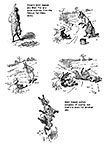 Highly regarded for his
paintings of sporting scenes, Frost also excelled at pen drawings of animals
and eccentric rustics. Winsor McCay, famed creator of the fanciful Little
Nemo in Slumberland, considered Frost "the greatest comic draftsman in
the history of the country." Highly regarded for his
paintings of sporting scenes, Frost also excelled at pen drawings of animals
and eccentric rustics. Winsor McCay, famed creator of the fanciful Little
Nemo in Slumberland, considered Frost "the greatest comic draftsman in
the history of the country."
Frost
was noted among his contemporaries for his comic depictions of black people,
one of which I've included here for the sake of the record. Cartoons of this
sort were common in the 1920s although by no means prevalent. 
The
benighted society that found humor in such cruel caricatures was, I hoped
(until the Age of Trump), becoming a thing of the past, and I have no wish to
extend its vitality any by bringing forward these savage old stereotypes.
Still, to leave cartoons like this out of our review altogether is to suppress
them as well as an unsavory part of our past— and thereby to misrepresent
history. And just as we need memory of the Holocaust to remind us how monstrous
we can be if our ethnocentricities are permitted unrestrained sway, we need a
caricature by Frost to remind us that racial stereotypes like his were wholly
fictitious (and still are). They had their origins in minstrel show
characters that were invented without much reference to real people by white
men in blackface to serve their comic purposes on stage.
Psychologically,
the blackface comedy of the nineteenth century stage served to quell anxieties
in white audiences that wished to justify slavery or (after resolution of that
issue) that feared an emerging black populace. In the 1920s, the cartoons of
Frost and others may have served much the same psychic function. Ironically,
at the same time that Frost's cartoons were making people laugh at lazy
ignorant rural blacks, the staff of Life and much of the rest of the
population of the nation's most urbane center often found its entertainment in
the city's nightclub mecca, Harlem.
At
the time, Harlem was a black metropolis, the black capitol of the world, and
the scene of a literary and cultural flowering that became known as the Harlem
Renaissance. Elsewhere in the country, blacks were suffering persecution
unparalleled since Reconstruction. Between 1918 and 1927, over 400 blacks were
killed by lynch mobs that were common in some rural areas. To assuage their
fear and shame, white Americans laughed at cartoons like Frost's.
It's
no good contending, as some historians have, that cartoonists who drew cartoons
with racial and ethnic stereotypes were having innocent fun with minorities
they otherwise respected. They respected those minorities no more than any
other white Anglo Saxon protestant of their time. But they also ridiculed the
KKK mercilessly— and consistently.
Other
unique stylists whose work is represented here include Gilbert Wilkerson, whose
brilliant studies in black and white and supple line appeared most frequently
in Judge; Gardner Rea, drawing in a manner only vaguely evocative
of the stark simplicity of his later style; Art Young, whose gentle and
genial nature is better reflected in his cartoons for Life than in his
savage attacks on social injustice in The Masses; and T.S. Sullivant,
whose anthropomorphic animals and Biblical buffoons had been committing
hilarities in Life since 1891.
Also
represented in the line-up below is the Jefferson Machamer girl, whose
figure not even the straight lines of flapper fashion could shroud; the Alice
Harvey girl, a modest maiden only slightly dingy; and the Ethel Plummer girl, a saucy flapper.
In
addition to showcasing the work of some of the best of the decade's
cartoonists, our series of Cartooning the Roaring Twenties also reveals the
state of the art of the single-panel (or "gag") cartoon during a
critical period of its evolution. Until the 1920s, the gag cartoon was merely
an illustration for comic dialogue that appeared underneath it in a series of
verbal exchanges. And the practice continued into the twenties as attested by
examples hereabouts. By the end of the decade, however, the single-speaker
caption had supplanted the multiple-speaker caption, and a new kind of cartoon
emerged.
In
the old gag cartoon, the humor resided chiefly in the words of the caption; in
fact, the picture was often entirely superfluous to the joke. In the modern
gag cartoon, words and picture are interdependent: the significance of the
drawing is made clear only by the caption or the utterance of one of the
characters in the drawing; by the same token, the import of the utterance is
evident only when the picture above it is understood. Word and picture blend
to create comedy that neither alone provokes.
Many
of the cartoons in this series demonstrate the evolution in thinking by which
pictures became integral to the humor of the gag cartoon. In the 1920s, a kind
of "visual wit" distinguished many cartoons. In such cartoons as Jack
Farr's, the humor arises entirely from the cleverness of the pictures. And
in cartoons like Ellison Hoover's, the words draw attention to the
picture, which, in turn, delivers the joke. Ditto Held's "Outlines of
History" cartoon (inspired by H.G. Wells' popular book with the same
title).
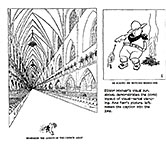 |
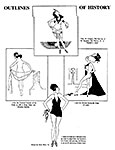 |
Cartoonists
doubtless noticed the greater comedic impact in cartoons of such verbal-visual
blending and began to strive for that effect. Despite the long-standing
tradition that Harold Ross and his cartoonists at The New Yorker invented the single-speaker captioned cartoon, the evolution of the gag cartoon
along these lines was evident long before Ross's magazine appeared on the scene
on February 21, 1925. (See Harv’s Hindsight for October 2004 for
an elaboration on this thesis.)
The
eccentric Ross's insistence on such niggling details as being able to tell which
of the figures in a drawing was speaking no doubt helped to focus his
cartoonists' efforts in the direction of single-speaker captions, and the
success, by the end of the decade, of his magazine over the foundering Life and Judge surely established the form even if it did not invent it. But
even The New Yorker published multiple-speaker captioned cartoons
through much of the decade. Still, it was clear that the old illustrated
verbal witticism was on its way out, and the cartoons we display below helped
to show the way.
Return to Harv's Hindsights |